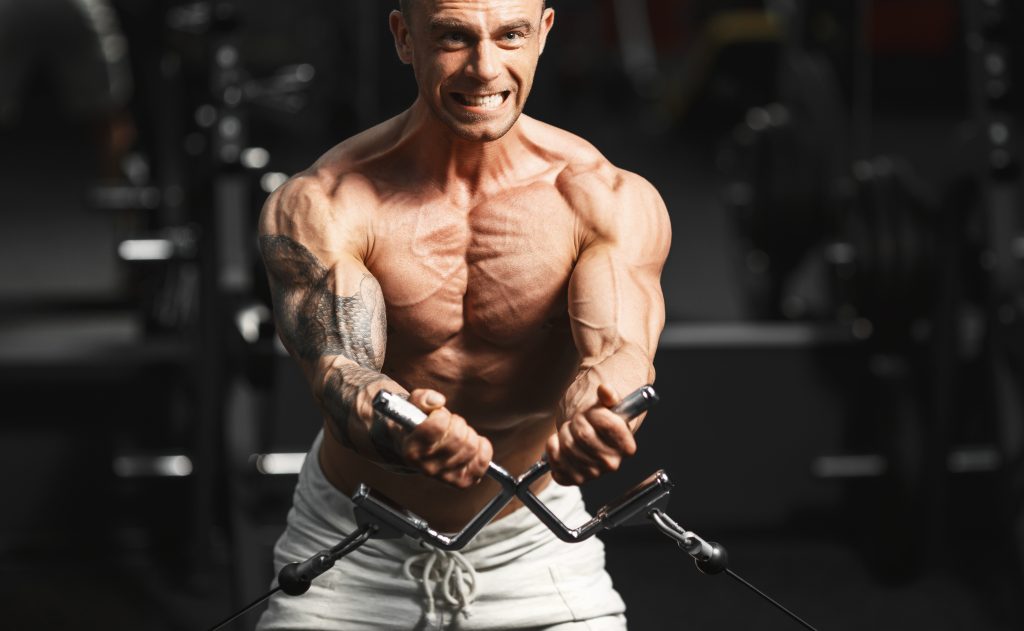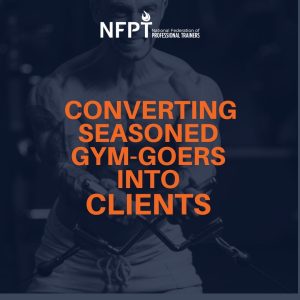Winning over seasoned fitness enthusiasts into new personal training clients can seem like a daunting task. They have the confidence and discipline to stick to a tough training schedule. However, you know they’d make great clients for those exact reasons – imagine their growth from working with a dedicated personal trainer!
Topics to Winning Seasoned Fitness Enthusiasts Over
How will you strike up a conversation with a member of this demographic, to hopefully transform them into your next A-list personal training client? Ask them about the following topics centered around their routine, goals, and potential challenges. I’ve discussed these five topics with potential new clients, leading to strong relationships with those who hadn’t realized the value of a personal trainer.

- Recovery
- Mobility and Stability
- Quality over Quantity
- Balancing Feelings with Science
- Time Constraints
Recovery
Seasoned fitness enthusiasts often excel in hard work but can struggle with recovery, leading to nagging pain and training plateaus. As a Certified Personal Trainer (CPT), you play a pivotal role in educating them about the significance of proper exercise recovery.
Find out what their philosophy on rest periods and recovery is. Many folks who hit the gym hard tend to believe that too much rest is weak. If you find that to be the case, tactfully explain that rest breaks between sets aren’t merely for catching one’s breath but are crucial for optimizing recovery in the nervous system. Communicate that muscles need adequate recovery before they can be pushed to the same high intensities to further progress. Cutting short this process reduces muscle growth potential.
When seasoned gym-goers realize that proper recovery can significantly improve their fitness outcomes, they’re more likely to recognize the value a personal trainer brings to their fitness journey. Cite research to back up your claims:
Recovery Intra-Workout
- “Rest intervals lasting more than 2 minutes are needed to maximize muscular strength gains in resistance-trained individuals” (Grgic et al, 2018)
Recovery Post Workout
- “Deloading might mitigate the risk of both physical and psychological fatigue, while facilitating recovery and adaptation” (Bell et al, 2013)
- Refuel and rehydrate
- Occasionally swap a workout with structured physical activity, like spike ball, a bike ride, or pickleball
- “Adjusting the training schedule to improve sleep duration has a significantly positive impact on several aspects of athletic performance” (Copenhaver & Diamond, 2017)
- Allow for 2-3 days of recovery in between intense workouts with optional recovery workouts in between
Mobility and Stability

Seasoned fitness enthusiasts often stick to their familiar routines, which can hinder their progress. They may not consider the benefits of unilateral vs. bilateral training, exploring different planes of motion, or incorporating mobility and stability work. Introducing them to core exercises like Pallof presses, or other unilateral variations of RDLs, glute bridges, or overhead presses can be eye-opening.
Witness their amazement as they uncover weaknesses and tightness they didn’t know existed. Even well-known mobility exercises can bring significant value to experienced lifters when introduced correctly. I’ve received enthusiastic buy-in from seasoned lifters by showing them these mobility exercises, enhancing their training experience and overall results.
- The World’s Greatest Stretch
- Hip 90-90’s
- Kneeling thoracic rotation
- Hip hinge lat stretch
- Oblique sling stretch
Quality Over Quantity
The age-old adage of “muscle confusion”, “more is better”, and constantly changing exercises isn’t always the most effective approach to achieve goals. Many seasoned fitness enthusiasts think they must constantly change their routines to make progress. As a CPT, you have the opportunity to educate them on the importance of consistency and the principle of progressive overload.
Guide them towards a core selection of multi-joint exercises tailored to their goals and consistently increase the intensity and load over time. Help them program exercise order for optimal results based upon their goals. When they start seeing concrete progress, they’ll appreciate the wisdom of sticking to a structured plan rather than chasing novelty.
Is More Always Better?
Research on training frequency and volume highlights a crucial point: more is only better up to a certain threshold. Once you reach a specific point in your workout or weekly volume, adding extra volume ceases to provide benefits. Moreover, excessive volume can lead to central nervous system fatigue, resulting in decreased performance and a higher risk of injury.
Research is still investigating the maximum volume per week before the dose-response graded relationship decreases. However, if your potential new client is performing 40 sets per week of chest, it is more likely than not that that is too much volume.
- 10 weekly sets a week per muscle group have been shown to increase muscle growth, with as little as 4 per week for certain populations (Schoenfeld et al, 2016)
- “Resistance training frequency does not significantly or meaningfully impact muscle hypertrophy when volume is equated. Thus, for a given training volume, individuals can choose a weekly frequency per muscle group based on personal preference” (Schoenfeld et al, 2019)
Exercise Order
Exercise order can make a difference in training! Seasoned fitness enthusiasts may be doing our favorite exercises, but not in the best order.
- “Increases in muscular strength are the largest in the exercises performed at the beginning of an exercise session. For muscle hypertrophy, [differing exercise orders may produce similar results]” (Nunes et al, 2020)
Single-Joint vs Multi-Joint Exercises
Veteran lifters may be adding excessive training volume with single-joint exercises or favoring them over multi-joint.
- “[Single joint exercises in combination with multi-joint exercises may be unnecessary] to obtain… long-term adaptations such as hypertrophy and strength. SJ exercises may only be necessary to strengthen lumbar extensors and to correct muscular imbalances” (Gentil et al, 2017)
- Counter-argument against this study “An evidence-based approach would thus warrant inclusion of SJ exercise in programs designed with hypertrophy as the primary goal” (Ribiero et al, 2017)
- “[Single joint exercises in addition to multi-joint exercises] does not seem to promote additional benefits to trained men” (de Franca, 2015)
Balancing Feelings with Science
Some seasoned fitness enthusiasts prioritize the “pump,” pushing themselves to the point of nausea, failure, excessive sweating, and intense next-day soreness. While these sensations can be motivating, they don’t always equate to optimal results. As a Certified Personal Trainer (CPT), it’s important to help them grasp the science behind muscle soreness and the necessity of balancing it with other progress indicators.
Encourage them to shift their focus toward achieving Personal Records (PRs), mastering movement patterns, applying progressive overload, and maintaining proper form. By doing so, they can achieve sustainable progress without the need to feel exhausted after every workout.
The Pump
The pump, known as cellular swelling, is a result of a very specific hypertrophy training technique, not just a feeling chased after. Here are some well-researched guidelines from researchers Brad Schoenfeld and Brett Contreras(2014):
- Only choose exercises that place a constant load on the musculature, as “cellular swelling is predicated on a prolonged venous occlusion”
- “Perform exercises in a continuous manner so that the target muscles are not allowed to relax”
- Employ “higher repetition sets combined with shorter rest periods”
- “[Perform pump training] ideally after heavier strength work, to take advantage of the multiple pathways involved in muscle hypertrophy”
Delayed Onset Muscle Soreness
- “Muscle [soreness] is not the process that mediates or potentiates… muscle hypertrophy” (Damas et al, 2017)
- “Mechanical force appears to be the primary stimulus for eliciting hypertrophic gains, [not muscle soreness]” (Schoenfeld, 2012)
Training Until Failure
- Training to muscle failure does not promote any additional benefits to hypertrophy in high loads (Lasevicius et al, 2022)
- “Training to muscle failure does not seem to be required for gains in strength and muscle size” (Grgic et al, 2021)
- “Training to failure should be performed sparingly to limit the risks of injuries and overtraining” (Davies et al, 2017)
Time Constraints
A 2017 narrative review by Iversen et al is an excellent resource for a one-stop location for all research related to a time-efficient strength and hypertrophy workout.
- Train multi-joint, bilateral exercises to train the most muscle mass efficiently
- Train leg pressing movements, upper body push, and upper body pull
- Incorporate supersets and drop sets
Conclusion
You are more than equipped to effectively assist seasoned fitness enthusiasts! They already have the prerequisites in place to expedite their progress with you. By focusing on these five key areas, you can establish a meaningful connection and demonstrate the value you provide on their fitness journey.
Remember that your role isn’t just about pushing them harder; it’s about educating, guiding, and helping them achieve their fitness goals in a sustainable and evidence-based manner. With the right approach, you can transform these seasoned gym-goers into loyal, satisfied clients who continue to grow and excel under your expert guidance.
References
- Bell L, Strafford BW, Coleman M, Androulakis Korakakis P, Nolan D. Integrating Deloading into Strength and Physique Sports Training Programmes: An International Delphi Consensus Approach. Sports Med Open. 2023 Sep 21;9(1):87. doi: 10.1186/s40798-023-00633-0. PMID: 37730925; PMCID: PMC10511399.
- Copenhaver EA, Diamond AB. The Value of Sleep on Athletic Performance, Injury, and Recovery in the Young Athlete. Pediatr Ann. 2017 Mar 1;46(3):e106-e111. doi: 10.3928/19382359-20170221-01. PMID: 28287684.
- Damas F, Libardi CA, Ugrinowitsch C. The development of skeletal muscle hypertrophy through resistance training: the role of muscle damage and muscle protein synthesis. Eur J Appl Physiol. 2018 Mar;118(3):485-500. doi: 10.1007/s00421-017-3792-9. Epub 2017 Dec 27. PMID: 29282529.
- Davies T, Orr R, Halaki M, Hackett D. Effect of Training Leading to Repetition Failure on Muscular Strength: A Systematic Review and Meta-Analysis. Sports Med. 2016 Apr;46(4):487-502. doi: 10.1007/s40279-015-0451-3. Erratum in: Sports Med. 2016 Apr;46(4):605-10. PMID: 26666744.
- de França HS, Branco PA, Guedes Junior DP, Gentil P, Steele J, Teixeira CV. The effects of adding single-joint exercises to a multi-joint exercise resistance training program on upper body muscle strength and size in trained men. Appl Physiol Nutr Metab. 2015 Aug;40(8):822-6. doi: 10.1139/apnm-2015-0109. PMID: 26244600.
- Gentil P, Fisher J, Steele J. A Review of the Acute Effects and Long-Term Adaptations of Single- and Multi-Joint Exercises during Resistance Training. Sports Med. 2017 May;47(5):843-855. doi: 10.1007/s40279-016-0627-5. PMID: 27677913.
- Grgic J, Schoenfeld BJ, Skrepnik M, Davies TB, Mikulic P. Effects of Rest Interval Duration in Resistance Training on Measures of Muscular Strength: A Systematic Review. Sports Med. 2018 Jan;48(1):137-151. doi: 10.1007/s40279-017-0788-x. PMID: 28933024.
- Grgic J, Schoenfeld BJ, Orazem J, Sabol F. Effects of resistance training performed to repetition failure or non-failure on muscular strength and hypertrophy: A systematic review and meta-analysis. J Sport Health Sci. 2022 Mar;11(2):202-211. doi: 10.1016/j.jshs.2021.01.007. Epub 2021 Jan 23. PMID: 33497853; PMCID: PMC9068575.
- Iversen VM, Norum M, Schoenfeld BJ, Fimland MS. No Time to Lift? Designing Time-Efficient Training Programs for Strength and Hypertrophy: A Narrative Review. Sports Med. 2021 Oct;51(10):2079-2095. doi: 10.1007/s40279-021-01490-1. Epub 2021 Jun 14. PMID: 34125411; PMCID: PMC8449772.
- Lasevicius T, Schoenfeld BJ, Silva-Batista C, Barros TS, Aihara AY, Brendon H, Longo AR, Tricoli V, Peres BA, Teixeira EL. Muscle Failure Promotes Greater Muscle Hypertrophy in Low-Load but Not in High-Load Resistance Training. J Strength Cond Res. 2022 Feb 1;36(2):346-351. doi: 10.1519/JSC.0000000000003454. PMID: 31895290.
- Nunes JP, Grgic J, Cunha PM, Ribeiro AS, Schoenfeld BJ, de Salles BF, Cyrino ES. What influence does resistance exercise order have on muscular strength gains and muscle hypertrophy? A systematic review and meta-analysis. Eur J Sport Sci. 2021 Feb;21(2):149-157. doi: 10.1080/17461391.2020.1733672. Epub 2020 Feb 28. PMID: 32077380.
- Ribeiro AS, Schoenfeld BJ, Sardinha LB. Comment on: “A Review of the Acute Effects and Long-Term Adaptations of Single- and Multi-Joint Exercises During Resistance Training”. Sports Med. 2017 Apr;47(4):791-793. doi: 10.1007/s40279-016-0664-0. PMID: 27995535.
- Schoenfeld BJ. Does exercise-induced muscle damage play a role in skeletal muscle hypertrophy? J Strength Cond Res. 2012 May;26(5):1441-53. doi: 10.1519/JSC.0b013e31824f207e. PMID: 22344059.
- Schoenfeld, Brad J. PhD, CSCS, CSPS, NSCA-CPT1; Contreras, Bret MA2. The Muscle Pump: Potential Mechanisms and Applications for Enhancing Hypertrophic Adaptations. Strength and Conditioning Journal 36(3):p 21-25, June 2014. | DOI: 10.1097/SSC.0000000000000021
- Schoenfeld BJ, Ogborn D, Krieger JW. Dose-response relationship between weekly resistance training volume and increases in muscle mass: A systematic review and meta-analysis. J Sports Sci. 2017 Jun;35(11):1073-1082. doi: 10.1080/02640414.2016.1210197. Epub 2016 Jul 19. PMID: 27433992.
- Schoenfeld BJ, Grgic J, Krieger J. How many times per week should a muscle be trained to maximize muscle hypertrophy? A systematic review and meta-analysis of studies examining the effects of resistance training frequency. J Sports Sci. 2019 Jun;37(11):1286-1295. doi: 10.1080/02640414.2018.1555906. Epub 2018 Dec 17. PMID: 30558493.
Brandon Hyatt, MS, CSCS, NFPT-CPT, NASM-CES, BRM, PPSC is an experienced leader, educator, and personal trainer with over 7 years of success in building high-performing fitness teams, facilities, and clients. He aspires to become a kinesiology professor while continuing to grow as a professional fitness writer and inspiring speaker, sharing his expertise and passion. He has a master's degree in kinesiology from Point Loma Nazarene University. His mission is to impact countless people by empowering and leading them in their fitness journey.


